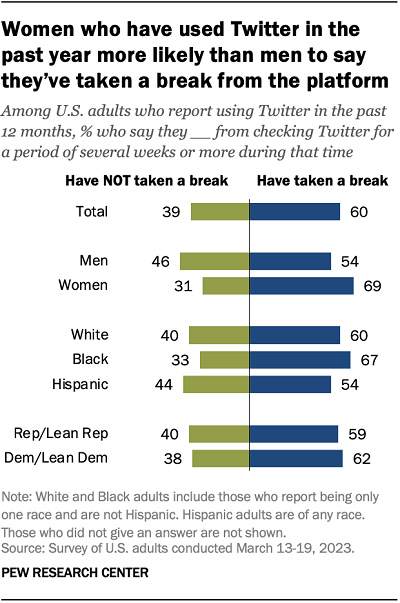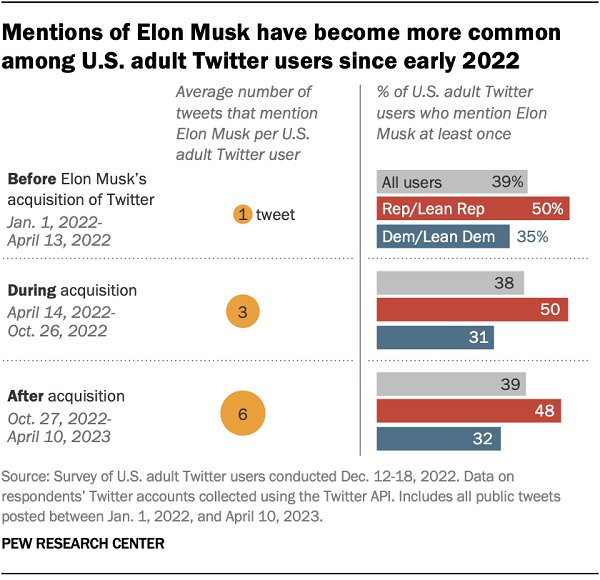Pew Research has shared some new insights into Twitter engagement pre and post Elon Musk’s takeover at the app, which shows that more users are taking breaks from tweeting, and that around a quarter of active Twitter users don’t expect to be using the app at all in 12 months time.
First off, on usage shifts – according to the Pew study, 60% of US Twitter users have taken a break from the app in the last year, while many of the most active tweeters have reduced their in-app activity following Musk’s acquisition of the app.

As you can see in this chart, female and Black Twitter users are the most likely to have taken a break from the app over the past 12 months, while Democrat voters are also more likely to have lessened their Twitter usage.
Many of Twitter’s most prominent users have also re-thought their Twitter addiction – as per Pew:
“The most active users before Musk’s acquisition – defined as the top 20% by tweet volume – have seen a noticeable posting decline in the months after. These users’ average number of tweets per month declined by around 25% following the acquisition. Despite this, eight-in-ten of the most active adult Twitter users between Jan. 1 and April 14, 2022, have remained among the most active users in the months after Musk formally acquired the site in October 2022.”
So most Twitter users are still tweeting, but there has been a marked decline in usage among various user groups.
Which also leads to this point:
“The survey also asked current and recent Twitter users how likely they are to use the platform a year from now. A plurality (40%) say they are extremely or very likely to use the site in a year, and 35% say they are somewhat likely to use it. But a quarter say they are not very or not at all likely to be on Twitter a year from now.”
Whether that means that people expect an alternative to arise, or they just don’t see themselves staying active, it’s not a great sign for Twitter’s growth plans, and its potential to reignite advertiser interest and activity.
But it’s early days, and with a new Twitter CEO coming in, things could change significantly, especially if Twitter can become a bigger video platform, as is seemingly the plan.
Pew’s data also shows that the vast majority of tweets still come from only a small proportion of Twitter users.
“A minority of adult Twitter users in the US continue to produce the bulk of the content. Since Musk’s acquisition, 20% of U.S. adults on the site have produced 98% of all tweets by this group.”
Twitter itself has said that 80% of Twitter users view the app in ‘read only’ mode, and never actually tweet, or engage with tweets in any way. Which is a key flaw in Musk’s Twitter Blue expansion plan, with most of the Blue incentives tied to tweet functionality or amplification – which most users don’t actually care about, or have any use for. That’s one of the reasons why take-up of Blue remains at less than 1% of Twitter’s total audience.
Also, this one should make Elon happy:
“On average, adult Twitter users in the US mentioned Musk in a tweet just once between January 1st and April 13th, 2022, before he announced his intention to acquire the platform. Since then, however, references to Musk have become much more common on the site. These users tweeted about him an average of three times between April 14th and October 26th, 2022 – while Musk was in the process of acquiring the platform – and an average of six times in the months after the sale was finalized.”

Elon certainly seems to like being the center of attention, and maybe, this was the main aim of his Twitter purchase all along, to become a more central character in modern pop culture, by getting more people to see and engage with his missives.
I mean, he did also try to make every Twitter user see his tweets.
These are some interesting notes on the latest Twitter usage trends, and how users view the changes implemented by Elon in his first six months in charge at the app. Though most of that early focus has been on cost-cutting, not on external development – and it’ll be interesting to see if this sentiment changes once Twitter gets on a proper growth track, and rebuilding the app in Musk’s desired image.
You can read the latest Pew Research Twitter usage insights here and here.



